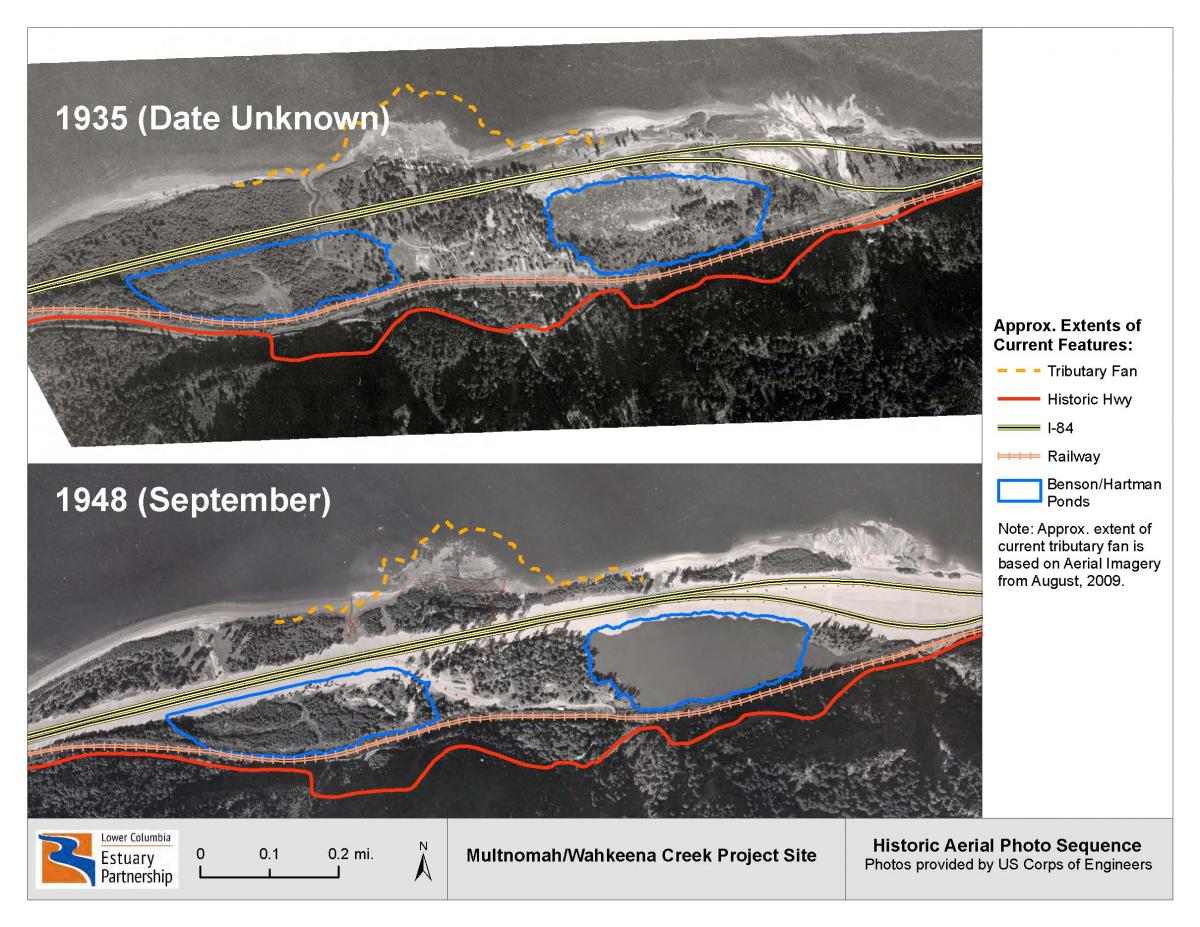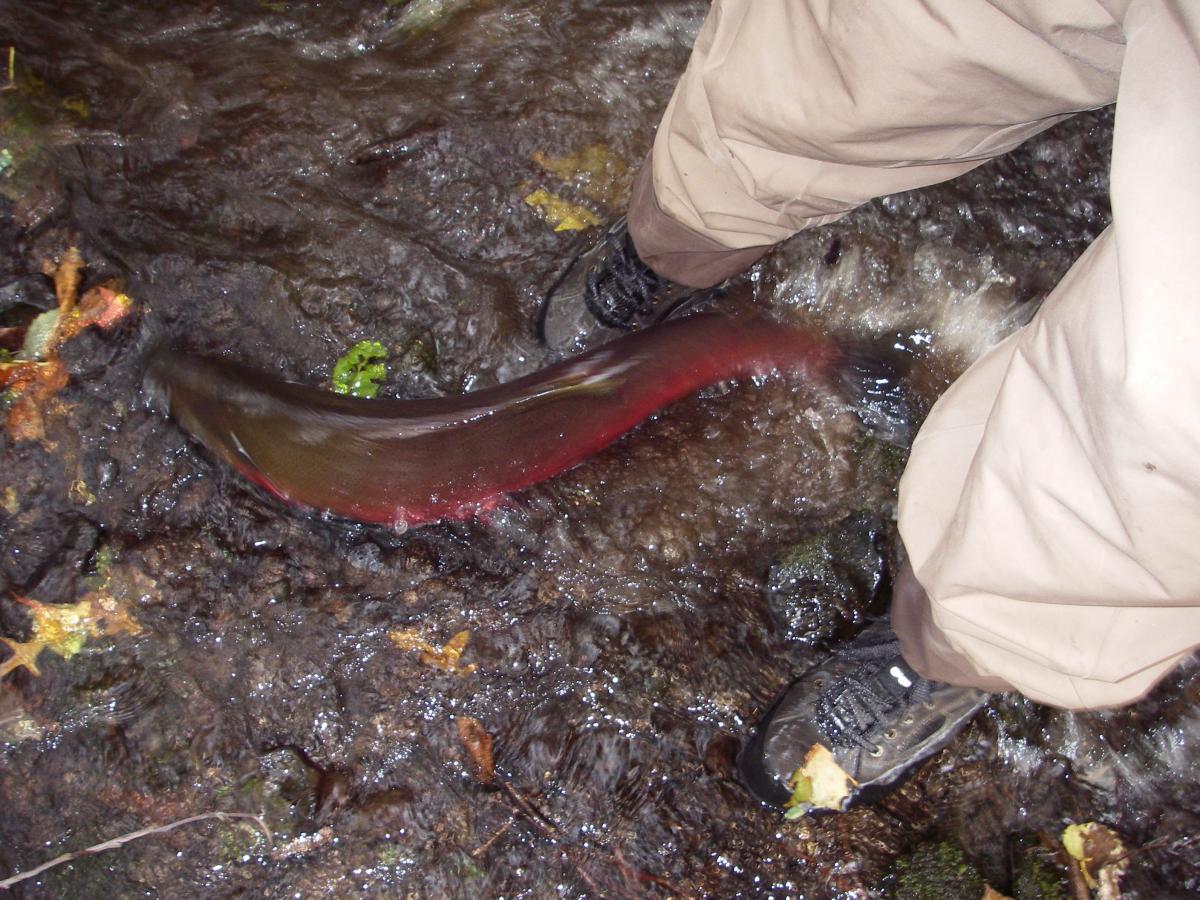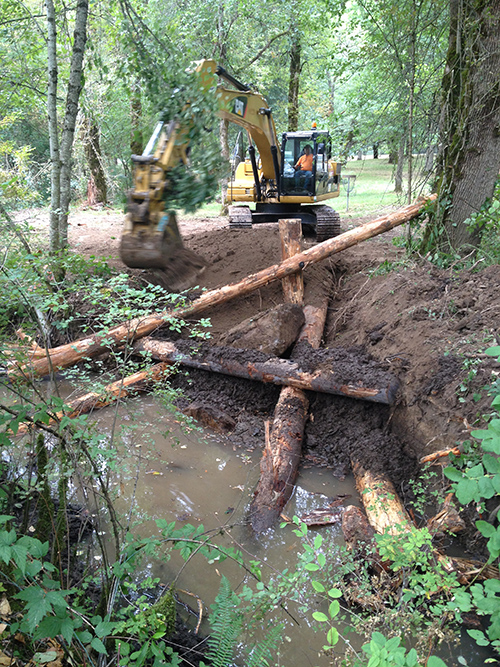 The Multnomah and Wahkeena Creeks Restoration Project will enhance two salmon-bearing streams near their confluence with the Columbia River. The project is located in Benson State Recreation Area within the Columbia River Gorge National Scenic Area, one mile west of Multnomah Falls and twenty miles east of Portland.
The Multnomah and Wahkeena Creeks Restoration Project will enhance two salmon-bearing streams near their confluence with the Columbia River. The project is located in Benson State Recreation Area within the Columbia River Gorge National Scenic Area, one mile west of Multnomah Falls and twenty miles east of Portland.
History:
The site contains two natural streams—Wahkeena and Multnomah creeks—as well as two man-made lakes—Benson Lake and Hartman Pond—which were created during the construction of I-84 in the 1950s. In historical times, the site was riparian forest, and both Wahkeena and Multnomah creeks flowed due north from their respective waterfalls and had individual connections to the Columbia River.
During I-84’s construction, two large gravel pits were excavated to generate fill material. All of Multnomah Creek was diverted through the larger gravel pit to form 22-acre Benson Lake, and a portion of Wahkeena Creek’s flow was diverted through the smaller gravel pit to form 20-acre Hartman Pond. Due to the creeks’ diversion, the water temperature of both creeks is higher than what acceptable for salmon habitat.
 Significance:
Significance:
Due to damming, habitat loss, and climate change, temperatures in the lower Columbia River exceed historical temperatures and are stressful for native salmon. Salmon migrating through the lower Columbia River during summer months seek out pockets of cool water to rest and feed. These cool water areas typically are found at the mouths of tributaries, where small plumes of water form that are cooler than the mainstem river.
This project is particularly important to the recovery of Pacific salmon and steelhead, which pass through the Columbia River estuary twice in their life-cycle: once as juveniles as they migrate out to the ocean and once as adults when returning to their natal stream to spawn.
The Restoration Project:
The restoration project replaces the current diversion structure in Wahkeena Creek in order to increase the flow of the creek and decrease the amount of water diverted to Hartman Pond, while maintaining a precise flow necessary to maintain the pond for recreational use throughout the year. Maintaining the pond’s recreational use was important to our partner, Oregon Parks and Recreation.
The Estuary Partnership science team determined how much water would need to be diverted to maintain the pond, while also allowing more cool water to flow downstream. Among other benefits, the increased Wahkeena Creek flows will reduce temperatures in Multnomah Creek at its confluence with the Columbia River by 2-3°C, bringing its peak temperatures down to approximately 16-17°C. These temperatures will provide thermal refugia for salmon migrating up and down the Columbia River. A secondary benefit is improving fish passage conditions at the I-84 culvert, the site’s only connection to the Columbia River.
Wahkeena Creek’s existing diversion structure was susceptible to clogging, and so could not meet the precise flow necessary. We replaced the existing structure with a new diversion structure that we are able to manipulate precisely. The new structure will allow us to divert the exact amount of water required to maintain Hartman Pond, and increase the flow of Wahkeena Creek to provide immediate improvements to water quality, temperature, and fish passage.
This restoration project includes several other actions to improve stream health in both the short- and long-term, including stormwater treatment, installation of logs as habitat structures, and planting native riparian vegetation. The state park’s parking lot was constructed in the 1950’s, prior to the implementation of current stormwater regulations—it had no stormwater treatment, and around half of its runoff flowed directly into Wahkeena Creek. To reduce the amount of untreated runoff that drains into the stream, we constructed a stormwater swale to capture and treat the runoff by filtering through native vegetation.
 Diverted streams designed by highway engineers in the 1950’s convey water efficiently, but the straight, uniform channels do not make for healthy fish habitat. The constructed portions of Wahkeena and Multnomah creeks almost completely lack habitat structure and diversity. To mimic natural conditions, we add logs, excavate pools, and plant native stream-side vegetation to convert these “ditches” into living streams that better support salmon and other native species. For this project, we are replanting riparian areas with native trees and shrubs. Thanks to support from the Goodman Family Foundation, local students will have the opportunity to help with two acres of this replanting effort. We are also aadding 80 large logs to create habitat where juvenile salmon can hide from predators and seek calmer water. The large logs provide an immediate increase in habitat quality, while the riparian plantings help restore natural processes, such as future shade and large woody habitat, yet take a decade or more for their benefits to build.
Diverted streams designed by highway engineers in the 1950’s convey water efficiently, but the straight, uniform channels do not make for healthy fish habitat. The constructed portions of Wahkeena and Multnomah creeks almost completely lack habitat structure and diversity. To mimic natural conditions, we add logs, excavate pools, and plant native stream-side vegetation to convert these “ditches” into living streams that better support salmon and other native species. For this project, we are replanting riparian areas with native trees and shrubs. Thanks to support from the Goodman Family Foundation, local students will have the opportunity to help with two acres of this replanting effort. We are also aadding 80 large logs to create habitat where juvenile salmon can hide from predators and seek calmer water. The large logs provide an immediate increase in habitat quality, while the riparian plantings help restore natural processes, such as future shade and large woody habitat, yet take a decade or more for their benefits to build.
Project partners:
Lower Columbia Estuary Partnership, Oregon Parks and Recreation Department, Oregon Department of Fish and Wildlife, and United States Forest Service.
Project funders:
Oregon Parks and Recreation Department, Bonneville Power Administration, East Multnomah Soil and Water Conservation District, Oregon Community Foundation, and J.W. & H.M. Goodman Foundation.
Contractors:
InterFluve, Inc. is leading the design of the project. Aquatic Contracting, Inc. is constructing the project.